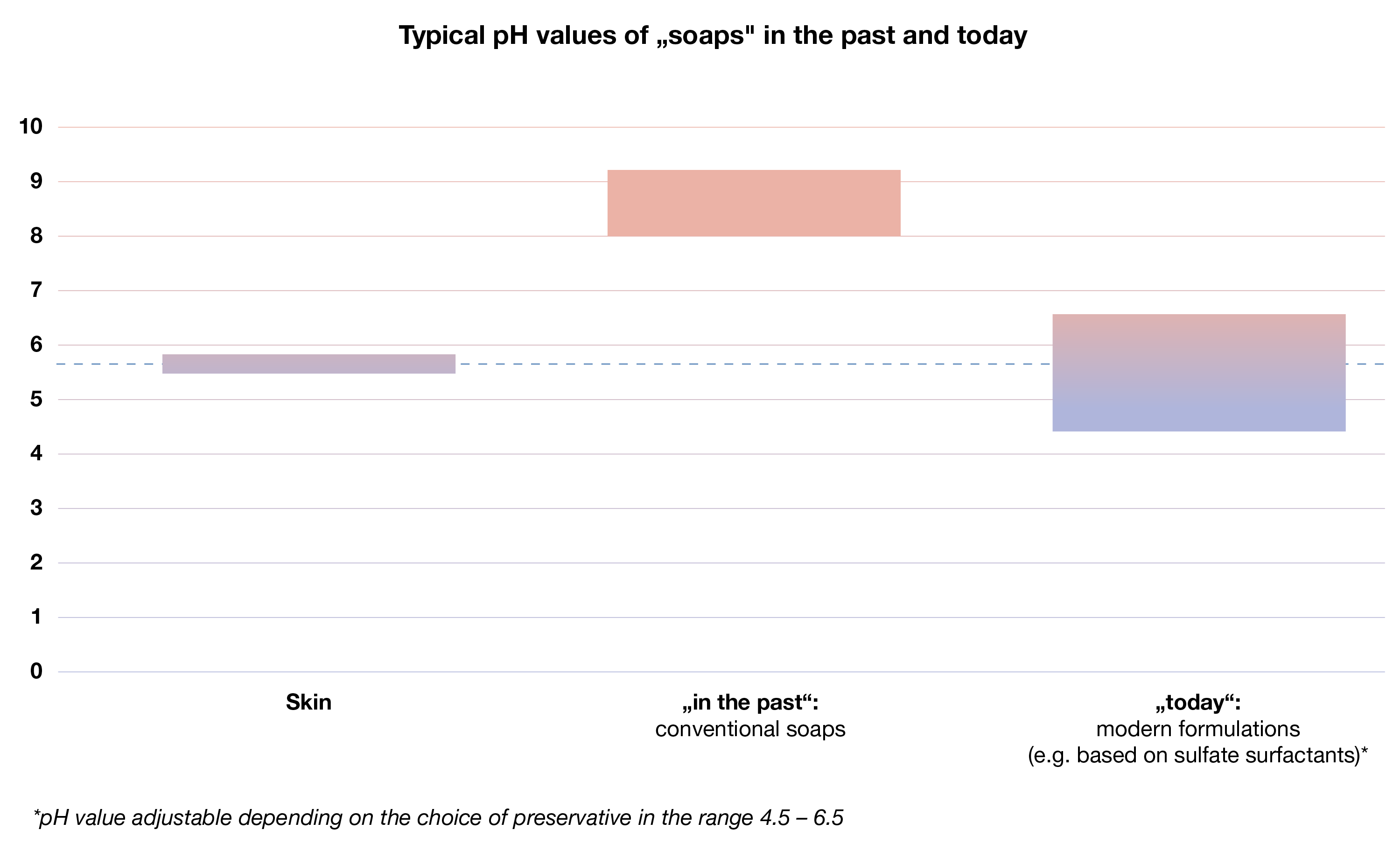
The world of sulfates
Shampoo – A success story since 1903
To take a quick look at the development history of shampoo, we have to make a small detour into the origins of cosmetics. These are not an invention of the last couple of centuries. They have existed almost as long as there have been humans on our planet.
Since time immemorial, cosmetics have been important to men and women. This includes decorative cosmetics just as much as body care products.
For now, though, let’s stick to hair care. It has a long, even very long, history. We don't want to dive too deeply into individual epochs or list the details of their specific recipes and formulas. Once you start listing ingredients you will find that, in addition to numerous well-known ingredients which are still found in cosmetic products today, some unexpected and very dangerous substances have been used in the past.
Surfactants have been in the mix for thousands of years
Some of these "hair care products" were cooked up following a recipe in kitchens or over fires and stirred together. We do not recommend reviving these. At some point, bars of soap became the hot favorite for hair washing, and the development of haircare products began. Developments also came through learning from the past.
A quick overview, in no particular order, of ingredients that have been used for hair care:
Soapwort, egg whites, apple vinegar, flavored vinegars, chamomile tea, oak apples, acorns, oak bark, wine, iron, quicklime, oils – e.g. almond oil + castor oil, vine root ashes, baking soda, tanning acids, alum, eggs, mercury, herbs, lizard fat, olives, lemons, beeswax, burnt lime, orpiment, curd soap, rosemary water, nettles, mint, incense, linseed, saffron, caraway, arsenic, henna, goat’s milk, elm bark, willow root, reed roots, stinging nettles, mint, thyme, onion peel, cognac, egg yolks, beer
Surfactants play an important role in this lengthy history, because our ancestors quickly realized: water alone is not enough. It was necessary to find additives and ingredients that could actually clean.
Saponins had a kind of pioneering role in this. Their cleansing properties have been known for thousands of years and are still in use today. Saponins are natural, plant-based surfactants that can be obtained from trees and plants. The category of deliberately produced surfactants was added around 2500 BC. The Sumerians living in Mesopotamia started making soaps from plant-based ash, animal ash and wood ash.
Soap is not the end of this road
If you were only aiming to clean your hair, the curd soap that was widespread at the time certainly did its job. It removed dirt, grease, dust and oils from your head, cleaned your hair and removed any unpleasant odors. However, the hair didn't feel nice after its “treatment”. Limescale deposits, which made the hair difficult to manage, were partly responsible for this. The alkaline pH of the soap did the rest. Remedial action: Lots of brushing and, if you could afford it, rinsing your hair with acidic essences.
Anyone who had a lot of time and money to spare would treat their hair with an extravagant blend of cognac and egg yolks every fortnight to make it shine. By the way, it was none other than Empress Elisabeth of Austria (1837–1898) who made this mixture popular. She was the wife of Emperor Franz Joseph and better known as Sisi. “I’m a slave to my hair,” she supposedly once said. Considering that she is said to have spent up to three hours a day caring for her hair together with her personal court hairdresser Fanny Feifalik, we can imagine just how important her hair was to her.
It would take until 1903 for a real innovation to take place. In 1903, many things happened. This was the year when Miele launched the first washing machine with a lid-mounted agitator, Harley-Davidson was founded, Ford’s first “Model T” rolled off the production line and the Wright brothers completed the first manned motorized flight.
Shampoo in a bag
It was also the year that moved the needle for hair cleaning in a totally new direction. For a few pennies per bag, it became possible to buy a hair shampoo in powder form. You simply dissolved this new powder in water and applied it to your hair. The first "all-in-one washing solution" for hair had arrived. The man who invented it? Hans Schwarzkopf. You will doubtless recognize the logo of his products: a black head ("Schwarzkopf" means "black head" in English).
Hans Schwarzkopf continued to drive new developments. As soon as 1927, he caused another sensation when the first liquid shampoo conquered the European market. Another world premier followed in 1933: Schwarzkopf launched a soap-free/alkali-free shampoo in the form of “Onalkal”. The route to today’s products was mapped out.
In the early 1930s, the chemical industry began to develop anionic surfactants on an industrial scale. Shampoos were among their first applications. More information here.
Today’s range of products for all needs and tastes
While the selection was very limited in the early days, the number of available shampoos has grown steadily, keeping pace with our scientific knowledge about the subjects of hair and scalps. Whether you have dandruff, a greasy scalp or colored hair: the right shampoo is available for almost every consumer. Customers are increasingly looking for product solutions that offer both well-being benefits and innovative textures. Want more volume? No problem. Here, too, product formulators have found the right solutions.
A long history of cosmetics
You might think that cosmetics were only invented in the last 100 years. Actually, they have been around almost just about as long as human beings have existed.
More informationIt is not just good-looking hair that plays a major role. Having healthy hair and a healthy scalp also matter. Microproteins, for example, have found their way onto the ingredients list of various hair care products. Due to their small size, they are able to penetrate deeply into the hair and build up an interaction with the hair's structures in order to strengthen them. What's more, thanks to their antioxidant properties, these hydrolyzed proteins are able to intercept free radicals that would otherwise damage the hair.
However, we do not want to ignore sulfate surfactants in this history of developments. Never forget that cleaning has been the priority since the early days of the "age of shampoo". Not even the slightest notice was taken back then of skin irritation, sensory properties, manufacturing sustainability and general biodegradability. Sulfate surfactants did their job: they cleaned. And did so in a way that nothing else could rival.
There is another major advantage over palm oil soap that can also be considered a real innovation: unlike traditional alkaline soaps, liquid soaps based on sulfates are able to match the skin’s slightly acidic pH without sacrificing any of their cleaning power. The term "pH balanced" became a key focus and to this day has lost none of its significance. Sulfate-based shampoos are still produced to be slightly acidic and are therefore "pH balanced" for the skin.
Shampoo is part of our everyday life
Some of you may still remember this: in the past, washing your hair wasn't always pleasant. Even though the shampoo came out of the bottle and no longer had to be mixed or cooked in the kitchen, it was still pretty harsh. It literally burned your eyes and you had to scrape and rub the foam that looked so good off your face.
Thanks to science and research, this no longer needs to be the case today. Although sulfate surfactants with their great cleansing properties are still part of the recipe, manufacturers can combine different surfactants and add different care and other ingredients in order to market products that a) are very good at cleaning, and b) feel very pleasant on the skin. With the right formulation, i.e. the right recipe, the sulfate surfactants are even used in baby and children’s shampoos without causing any tears. Since not only the formulation and composition of shampoos are different, but also what people want in terms of sensations and skin care, you may well find that one or other shampoo is more compatible with your skin. Sometimes you just need to test and try them out for yourself.
Developments never stop
In addition to customer requirements, the regulatory authorities also have a major influence on product development. Environmentally harmful substances are under close scrutiny and subject to bans. This is a situation that BASF has been dealing with for years. We apply our experience and passion to our research and work on product solutions, so that we can satisfy our own desire for sustainability while still achieving high product performance combined with product quality. Our researchers and experts are constantly analyzing trends and what consumers want. They are pioneers in the development of new formulations and assisting manufacturers on all issues relating to applications.
Personal care products should not only work, they should also be enjoyable and give people a good feeling all round. Shampoos are no exception. Surfactants linked to “burning” sensations should only be an issue for firefighters. Why? Because they and their foam are successfully used to extinguish fires.


